I mentioned in last week’s article on Dylan Cease that I’m a bit of a visual learner (sometimes). So get ready for some visuals! First without context. Here’s a GIF.
Personally, my pitching experience only amounts to a Division III ERA over six, but most pitchers at any competitive level will tell you that sometimes, when throwing a pitch, you just know from the moment the ball leaves your hand that you’ve made a big mistake. This is the expression of a pitcher who knows he’s just made one of those pitches.
And this is the expression of a pitcher who knows he’s been making far too many of those pitches lately.
That about sums up how things have gone for Luis Castillo this year. If you head over to the FanGraphs leaderboards—as you probably do with some frequency, if you’re reading me here—and you set the innings minimum to 30, you’ll find Castillo dead last among 122 starters with a brutal 7.71 ERA, more than a half-run worse than runner-up Mitch Keller. ERA estimators like FIP, xFIP, xERA, and SIERA all think that’s a bit exaggerated, mostly pegging him in the high fours, but even that isn’t super reassuring, as he ranks between 88th and 100th out of those 122 in all four categories. A quick glance at Castillo’s peripherals tells us what we should be looking deeper at:
Castillo’s difficulties can’t be chalked up to luck, in spite of the randomness that goes into any ERA that high. His BABIP is a career-high .385, and that will certainly come down, but I highlighted those strikeout and swinging strike rates for a reason. How does a Pitching Ninja darling who’s struck out 10 per nine innings for his career start pitching more like Adam Wainwright than La Piedra? That’s not an exaggeration, either. Looking at the names surrounding him on the swinging strike leaderboard last year (right) compared to this year (left) highlights just how precipitous that six-point drop in SwStr is. (Leaderboard courtesy of Alex Chamberlain.)
 |
 |
Big Yikes™ for Brad Hand and Patrick Corbin, but man, Luis, what happened? The answer is just as intuitive as pointing to his strikeouts next to his bloated ERA. His lack of swinging strikes isn’t coming from fewer swings, or fewer pitches in the zone, which is what often happens to pitchers who lose their feel and command. Instead, Castillo’s getting fewer whiffs because when hitters do swing, they’re making far more contact than they ever have before.
It’s not stemming from just one pitch losing effectiveness, either. His decrease in whiffs per swing has been a problem completely across the board.
Somehow, all of this is even worse than it looks. Looking at 2020 and 2021 leaderboards, Castillo is the only qualified MLB starter to rank in the top ten for whiff rate decreases for not one, not two, but three different pitches. (Stats through 5/15)
Not a very promising look for Lucas Giolito, Matthew Boyd, and Zach Plesac, two of whom were examined in depth by our own wonderful Michael Ajeto, who came to entirely rational explanations for both of their struggles. Castillo, however, is less straightforward. Perhaps it’s why he’s been a popular subject as of late. Kyle Horton and Nick Pollack (whatever he knows) both cited a downturn in command for Castillo’s struggles, with Nick presenting some pretty compelling video evidence, but I think there’s also another ingredient to these magical disappearing whiffs. While the command certainly has dropped a tick, as I’ll show in a moment, I don’t think it’s enough to derail a season like this because, for the most part, his control seems to be fine. His walk rate is decreasing for the second straight season, and while his zone rate is down a few ticks, it’s still higher than it was during his dominant 2019 season when he threw just 41% of his pitches in the zone. More tellingly, his rate of pitches over the heart of the plate is actually down a point or two this year, meaning that even though his command does seem shaky, it’s on a more subtle level than accidentally leaving more pitches over the middle.
Moving just beyond the heart of the plate, it’s what’s happening when he throws the ball in the zone overall that’s the crux of Castillo’s woes. Back to visual learning! Here’s a really scary chart.
Ooolala. This is more than just a cold streak. There’s something wrong. Folks with stuff that good don’t get 90% contact rates in the zone. But it’s not just that—hitters are suddenly making way more contact with everything out of the zone, too. When you put it all together, the picture is pretty clear.
Contact goes up, strikeouts go down. About as intuitive as it could possibly be. It tracks with a suspicion that there’s a bit more going on here than mechanical hiccups and poor command. On the whole, he’s giving up contact at a rate entirely unprecedented for him—and it’s not like he’s never had bouts of poor command before. Let’s keep looking.
Pitch By Pitch
This is where we get granular. The changeup is and has always been Castillo’s bread and butter. It’s been one of the game’s filthiest over the past several years.
Luis Castillo was 99% sure this changeup was a swinging K when it left his hand.
Then nods to Santana “good take.” pic.twitter.com/NntsofEHpx
— Rob Friedman (@PitchingNinja) August 6, 2020
So when you break down his pitch by pitch results from the last two years compared to this year, it’s the sudden ineffectiveness of the changeup that really sticks out like a sore thumb. This chart is a lot to swallow, but it’s pretty digestible once you know what to look for:
Honestly, you can ignore most of that. It’s there for the sake of painting a complete picture. As Horton pointed out, there’s not a super substantial difference in any of his pitches themselves, or at least, nothing that he’s never done at some point before. With the exception of the reduced whiffs, Castillo’s four-seamer has performed more or less the same as ever, but his sinker—which was arguably the better of his two fastballs until this year—has been absolutely pummelled.
This isn’t necessarily super noteworthy. Fastballs are bad, sinkers are worse, both get crushed, and you should probably lean on them as little as possible. But all pitchers have to lean on them to some extent, and Castillo is no exception. As you’ll see in Nick’s video that I linked about, this is where poor command does come into play. Here’s a heat map of where he threw his four-seamers and sinkers in 2020, compared to where he’s been throwing them this year.
 |
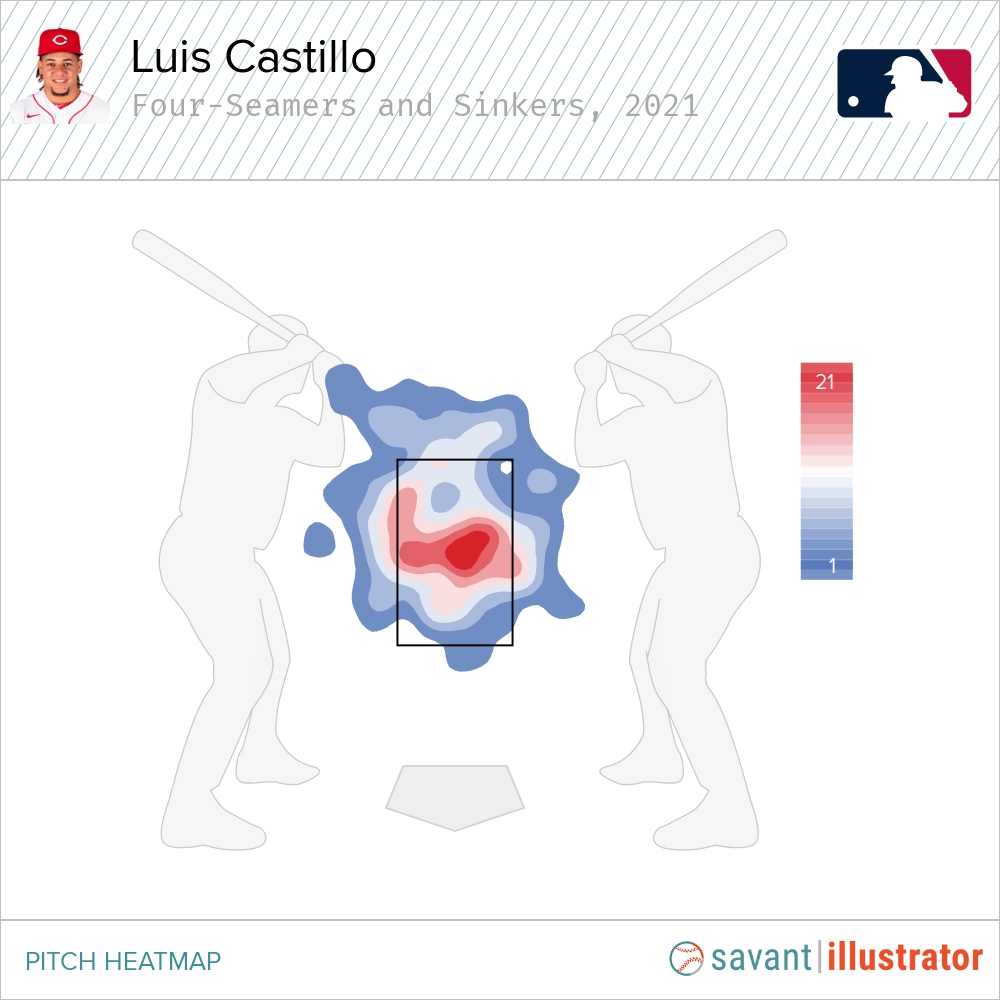 |
This is definitely a “don’t try this at home, kids” type thing. Two pitches in one heat map makes very little sense 99% of the time. It tells us something here, though. Naturally, Castillo uses the two pitches differently; living upstairs with the four-seamer while pounding the edges and lower part of the zone with the sinker. In the heat map on the left, you can see that while there are a few hot zones, you don’t see any one location singled out heavily. It’s clear that he was adept at moving his fastballs around, which is probably in part what made his sinker effective. This year, that’s not the case. The sample sizes are growing almost as big as last year’s, and the difference is stark. He’s just leaving his fastballs more down the middle and letting them run together far more than he did last season. A four-seamer can live without deception. Here’s 98 MPH at your neck, try to do something with it. Deception, whether it be through movement, tunneling, or the pitcher’s windup, is a bigger part of the two-seamer’s game, and when it has none—when it’s getting put in the same spot as the four-seamer consistently, and that spot happens to be right down the middle—it’s going to get crushed. That’s likely far from the only explanation for his sudden sinker woes, but I’m willing to bet it’s one of them.
That’s not even the interesting part, here. Full disclosure: I don’t have much to say about his slider, because my articles are long enough as it is. His slider is nice, but if his changeup is working, he can at least live without it. If the changeup isn’t working, however, Castillo’s arsenal is blown up worse than the Venetians at the Parthenon.
That’s a problem! And boy, is his changeup not working the way it’s supposed to this year. Let me run back that chart real quick, but just with the changeup part, to make things a bit easier on the eyes:
Before you ask about spin and movement, which is usually the first move when we’re looking at things on a pitch by pitch level, know that the pitch’s attributes, like Horton described, are essentially unchanged, save an extra inch and change of drop likely coming from small but relatively insubstantial decreases in velocity and active spin. But anyway—holy mother of God look at that whiff rate! This is supposed to be one of the best pitches in all of baseball. Elite pitches don’t get their whiff rates cut in half overnight. And it hasn’t been weak contact, either, seeing a 50% increase in its hard-hit rate (batted balls >95 MPH). What on earth is happening?
Spoiler alert: I’ve got no idea. Truly. Every single one of these articles is in the realm of mere speculation, but I’m kind of at a loss for this one. At first, a look at locations might hint at some of the same command issues that were alluded to with the fastball.
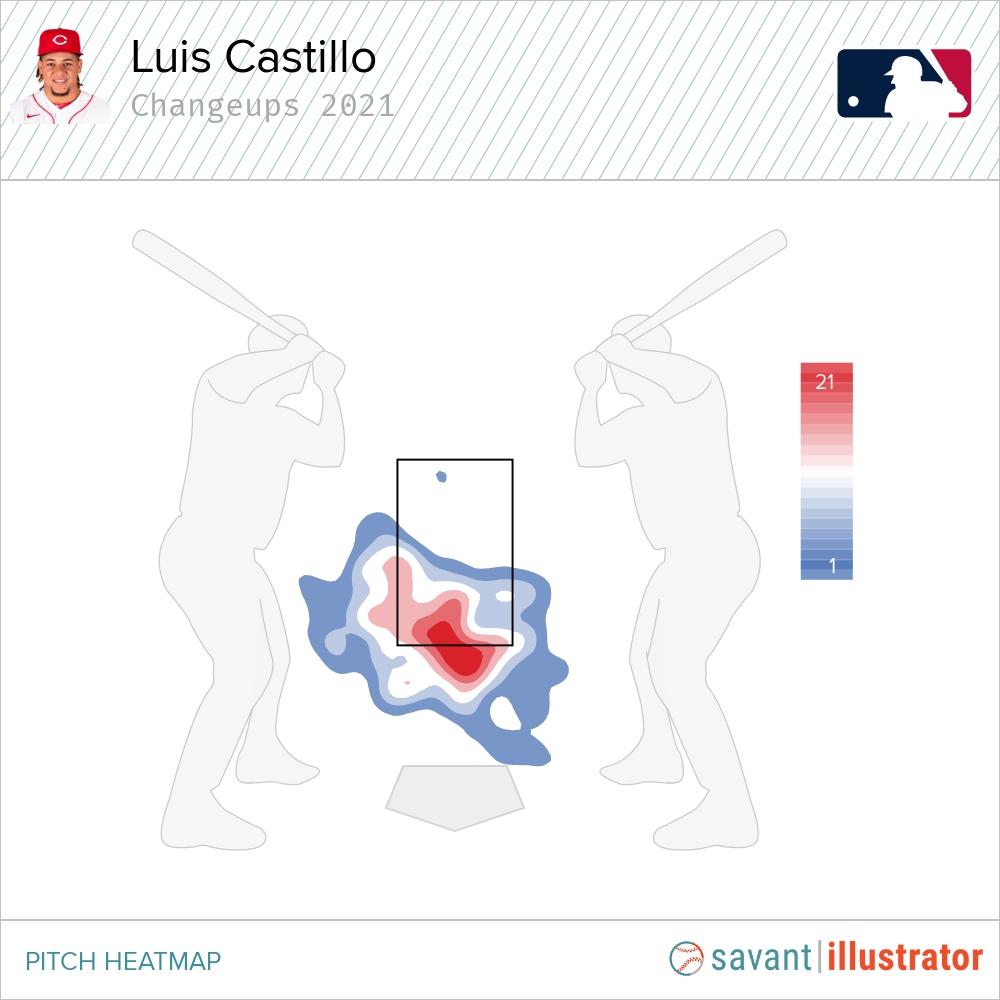 |
 |
Seems like we have our answer, yeah? In the past, Castillo was phenomenal at painting that lower corner of the zone to right-handers, low and away to left-handers. Especially with the timing difference coming off a 97 MPH heater, that’s an unhittable pitch. Now that it’s catching far more of the middle of the plate? Maybe not so much.
Looking a little further tells us that there’s still something more going on. Again, I’m not convinced that location is the main demon that needs to be slain. Let’s look at those two charts from a different perspective. If you look at the changeup’s whiff numbers in each of those locations, it looks like something bigger than a location issue. This is a lot of charts, I know, so bear with me, we’re almost done with the visual learning!
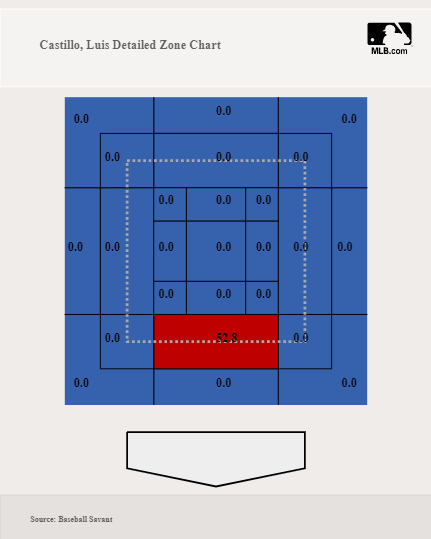 |
 |
What you see on the left (2019-20) and right (2021) is Attack Zone 18, which is the zone where the majority of Castillo’s change pieces have moved this year. The numbers you see are Castillo’s whiff rates in that particular area. In the past, Castillo was utterly dominant in this part of the zone, drawing whiffs on more than half of the swings taken on pitches down there. Now, even in what should be a prime spot for a changeup, he’s lost more than 20 points off that pace.
Just to double-check, we can do it a different way, too. Let’s do the exact same thing but with Gameday Zone 7, which is, in theory, the sweet spot of where Castillo’s changeups were clustered prior to this season.
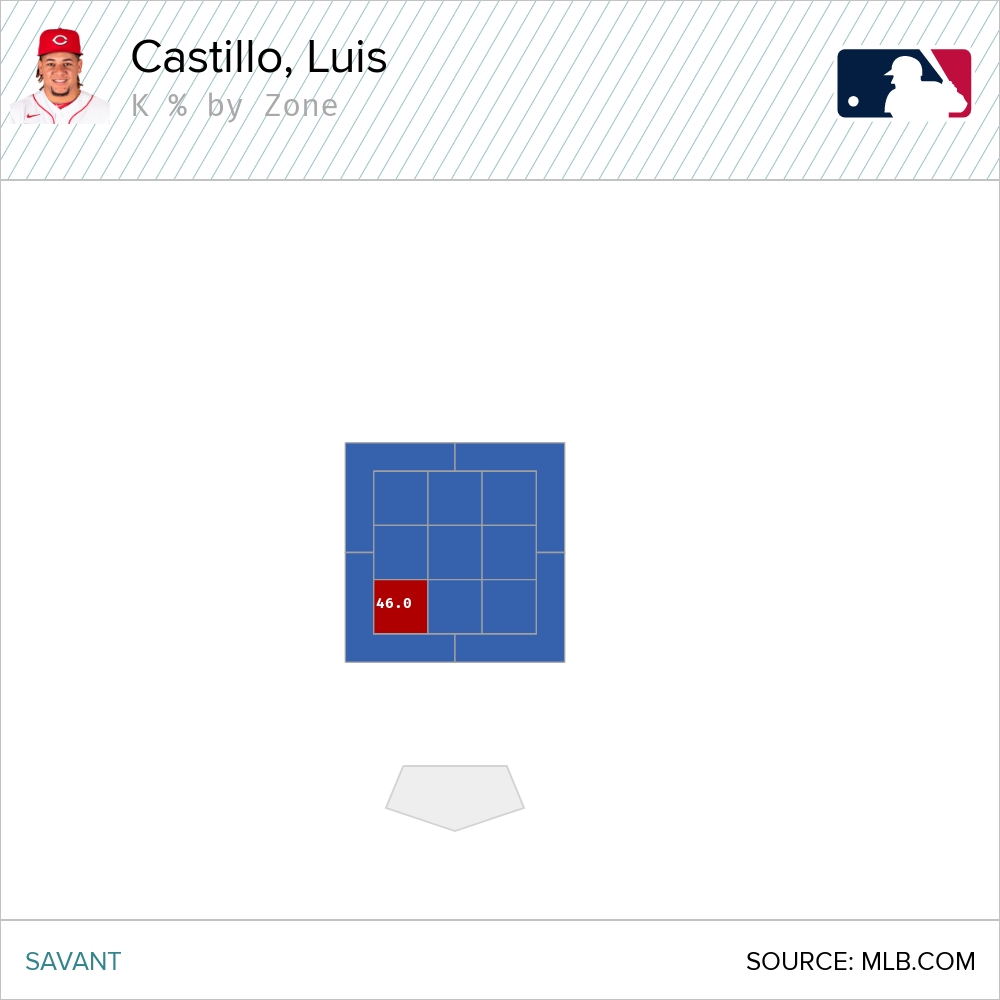 |
 |
This chart is a little bit different because Baseball Savant can be annoying sometimes. It’s the strikeout rate of pitches in that zone, i.e., what proportion of at-bat ending changeups in that zone went for strikeouts. It’s a much more noisy and less interesting stat, but it tells us the same thing: changing locations probably isn’t the culprit. If you want it number form, whiffs per swing on those pitches has an even sharper drop, decreasing from nearly 43% in 2019-20 to a measly 16% in 2021. Even when Castillo does put the changeup in the areas where it found success in the past, that success has suddenly evaporated.
Once again: I don’t know! Several others beyond Horton and Pollock have taken good shots at breaking down Castillo’s struggles, including Tony Wolfe at Red Reporter, Doug Gray at Redleg Nation, and Kenny Kelly at Beyond the Box Score, but there’s no single diagnosis for what’s been happening. Given that the attributes of the pitch itself have hardly changed, and Castillo himself hasn’t changed dramatically, it’s really tough to put a pin on his struggles, because they’re happening literally across the board, across all aspects of his game.
There is one more possibility that I haven’t dived into, and only now do so reluctantly, because it’s essentially impossible to do much more than project when it comes to tipping pitches. But tipping pitches has indeed become a buzzword with Castillo over his last few starts, as a quick Twitter search will confirm.
He noticed there is Jersey between belt and glove for fastballs and on belt line for change. Was pretty regular and was looking at savant on pitch by pitch and jived. Not 100% of time but quite often and noticeable.
— Michael Gary Scott (@neillious) May 9, 2021
Unfortunately, I haven’t had the time and wherewithal to watch a whole lot of video and squint and see if I can pick up anything that might be tipping. I hate even suggesting that he might be tipping, because unless it’s criminally obvious, tipping is one of those distant things that we’re just probably never going to know concretely. So it feels like a bit of a cop-out.
But I’m out of other explanations. The small changes Castillo has made in pitch mix, pitch location, and pitch movement are probably enough on their own to explain a lot of the things that have gone wrong with him this season, but I’m uneasy accepting that this can fully explain the dearth of swings and misses. I’m suspicious of the fact that the decline in whiffs is across the board—remember, he’s in the top ten for lost whiffs for three different pitches. I also find it unlikely that shaky command allowing for a few more fat pitches per game can be solely responsible for both the lost whiffs and the huge step backward in contact quality. That’s a lot of destruction to be wrought by missing a few pitches by an inch or two more than usual. Baseball is a game of tiny margins, but the way Castillo has been pitching, this one particular margin is a little too small of a detail to be responsible.
Again. I know nothing! I’m not even going to say that I think he’s tipping pitches, because I don’t think I know enough to make the most lightly educated guess. Tipping pitches is enough of a rare and tough-to-pick-up phenomenon that I think any analyst should have much harder evidence than I do to really make that charge. All that being said, I’ll leave you with one more graph, this time comparing his out-of-zone swing rate with his out-of-zone contact rate.
What we see towards the far right is that his chase rate (O-Swing%) is a little elevated, but not anything we’ve never seen before. The amount of contact hitters are making on those out-of-zone pitches has spiked to absurd levels, however. On May 8 against Cleveland, hitters made contact on 70% of their swings out of the zone! For a pitcher who throws 98 with the kind of movement his secondaries get, that’s a pretty absurd number. In 2020, Castillo ranked 15th out of 102 qualified pitchers in out-of-zone contact rate. In 2019, he was seventh out of 131. This season, with a slightly lower qualifying bar, he’s 150th out of 171. Even when it’s out of the zone, it’s almost like they know what’s coming.
When so little about a pitcher himself seems to have changed, and you see a drop like that, it’s hard to not wonder if something’s up. As I’ve repeated ad nauseum, I know nothing. What I do know is that Luis Castillo is not pitching like himself and that neither his pitches nor his location is different enough to account for it on their own. Probably. God only knows. The stuff is still there, and the command doesn’t look unfixable, so as miserable as it’s been for Reds fans and those who may have him on their fantasy train, I have a feeling a positive turn is coming sooner or later. It’s hard to run a 7 ERA for a full season when you’re that talented. And if something nefarious is it play, when Castillo gets back, he’ll be back.
Tipping pitches or not, it’s been a month and a half to forget for Luis Castillo. What’s important—if not to him, then to me—is that the materials are still there to make us forget all about that first month and a half really quickly. I hope he does.
Photo by Jimmy Simmons/Icon Sportswire | Feature Image by Justin Redler (@reldernitsuj on Twitter)


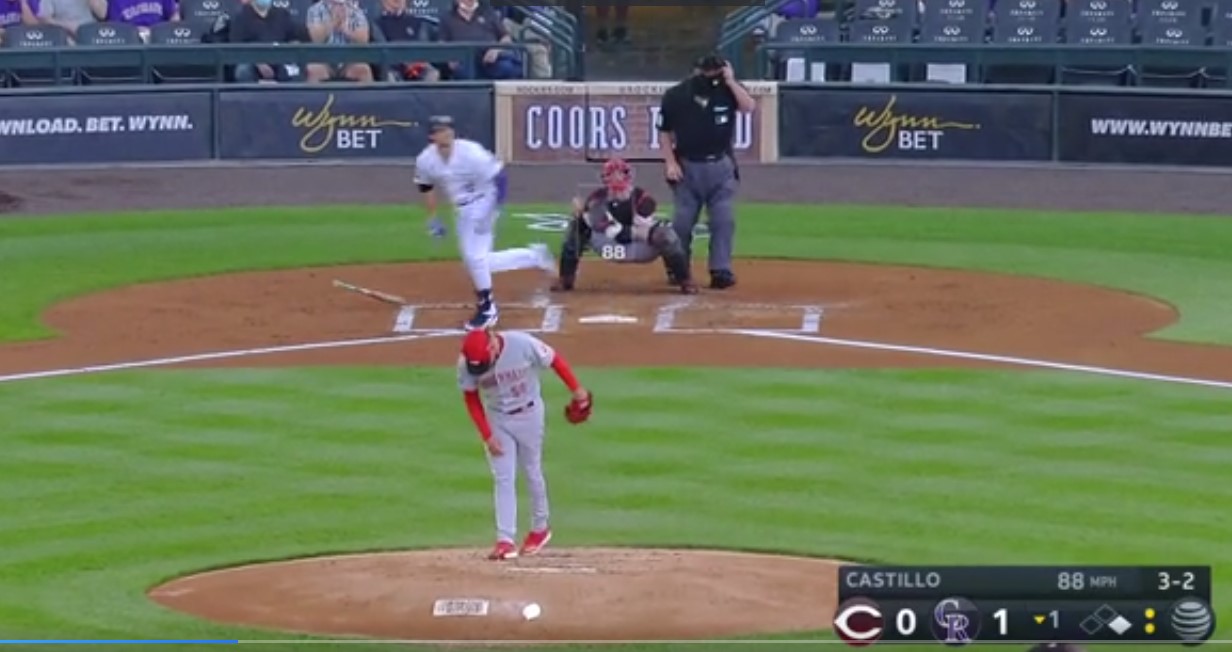

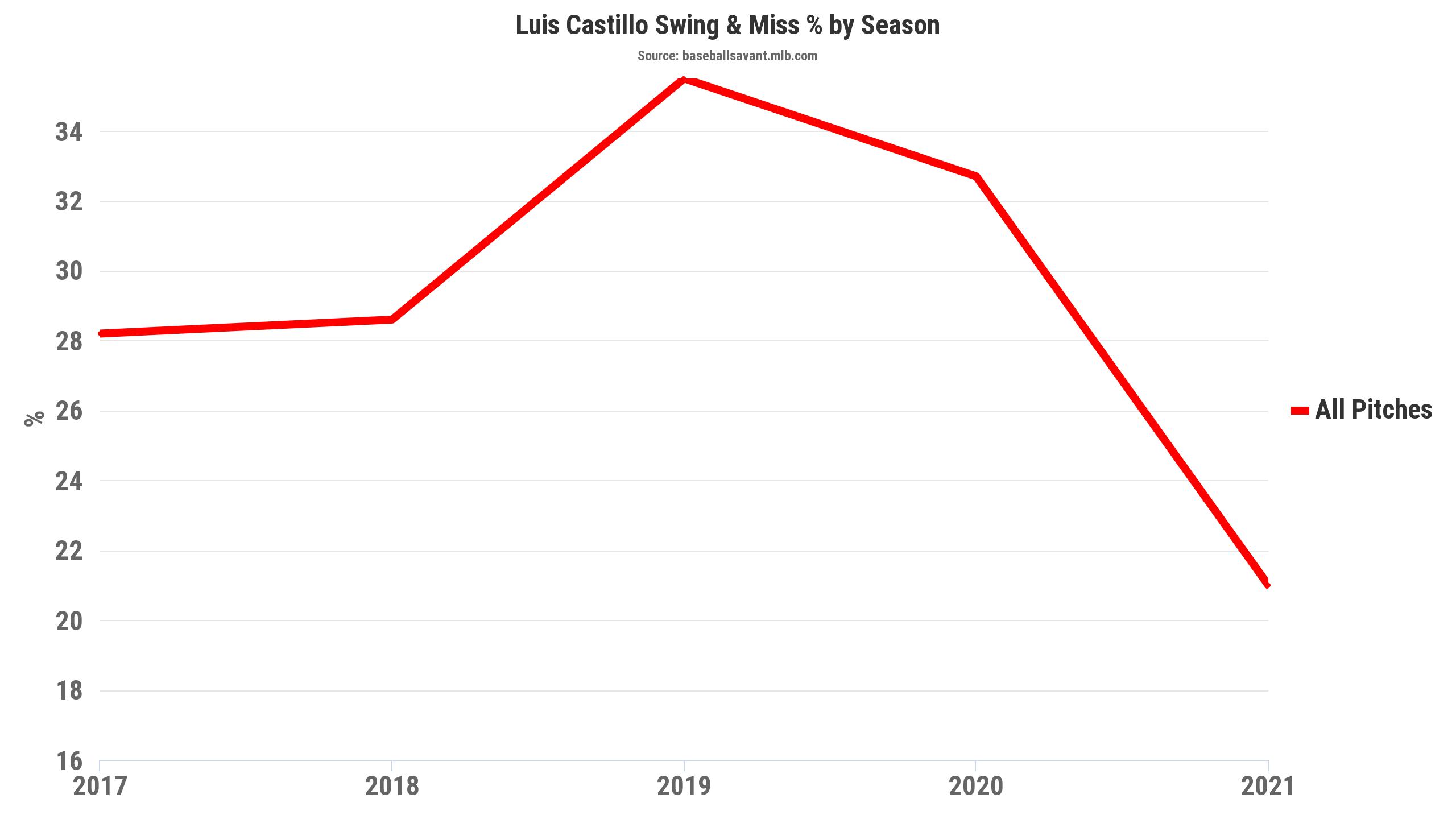
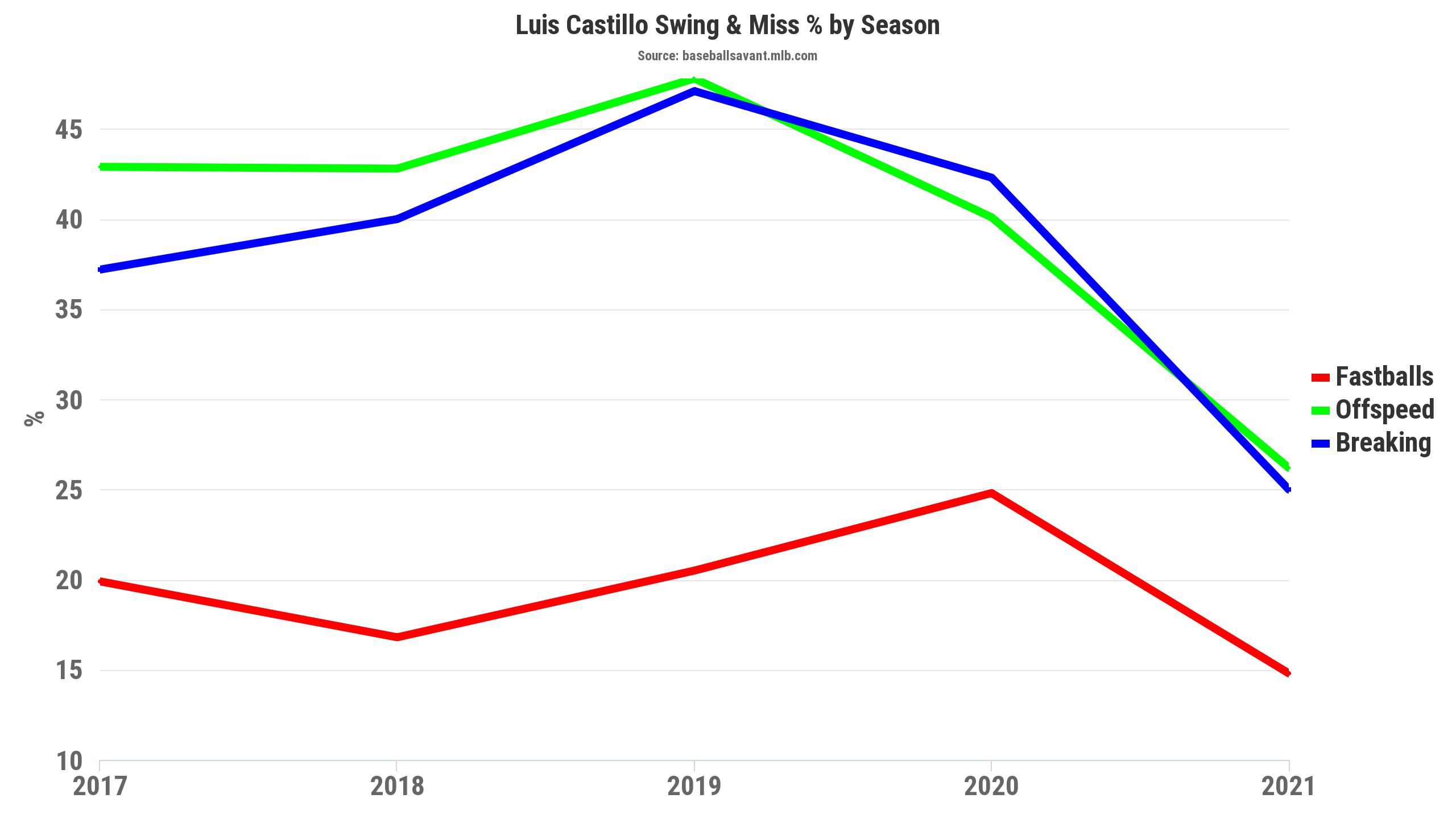

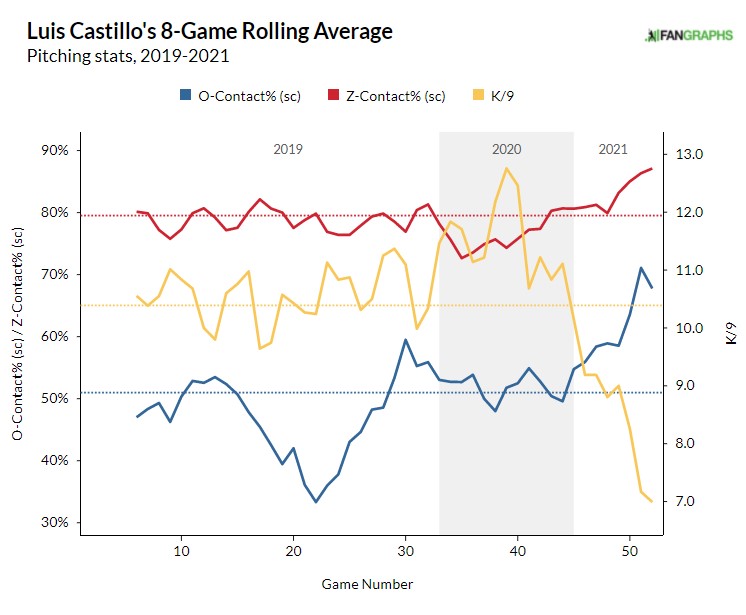
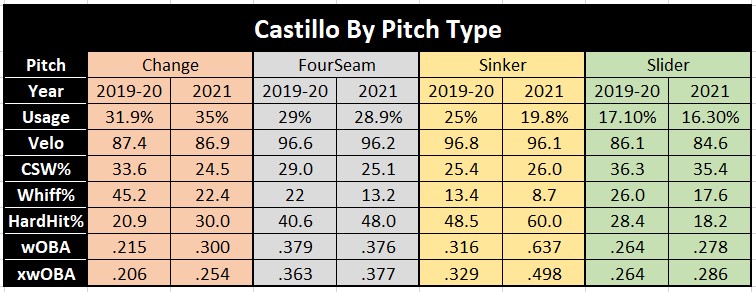


Is it possible that rather than tipping, he’s just predictable? Fastball always up, changeup always down – maybe certain counts are giveaways and people just know where to look?
Better scouting could definitely be a part of the picture! But when your stuff is *that* good, sometimes it just doesn’t really matter, and I think that’s usually been the case with Castillo. Mariano Rivera was pretty predictable too, after all!
Fangraphs’ Justin Choi didi a deep dive on his changeup that was posted a few hours before this that’s worth a look – https://blogs.fangraphs.com/much-ado-about-luis-castillos-changeup/
Not that I’m changing alliances, this is still my first site to go to every day before setting lineups and making roster changes. Love this site.
Justin’s article is great! We come to some different conclusions but I think they complement each other very well. It’s also a little hilarious, because we just recorded a podcast together a couple days ago and had no idea these were coming.
Yeah, I agree they compliment each other, only brought it up because I thought it had some interesting takeaways and as FBB MGR’s we’re often looking for all the perspective we can get.
Also that was a Fangraphs, not a Rotographs piece, so the differences may have come, at least somewhat, from real-game vs. fantasy production standards? IDK.
Great work
The only thing that makes sense to me is tipping pitches. I know it’s one pitch, but that GIF of him thinking he had the K on the change, and then the batter laying off, kinda tells me that. He’s not THAT predictable, and that was a PERFECT pitch….he didn’t even flinch. Nothing else makes sense honestly
Really nice work! Now do Charlie Morton. ;)